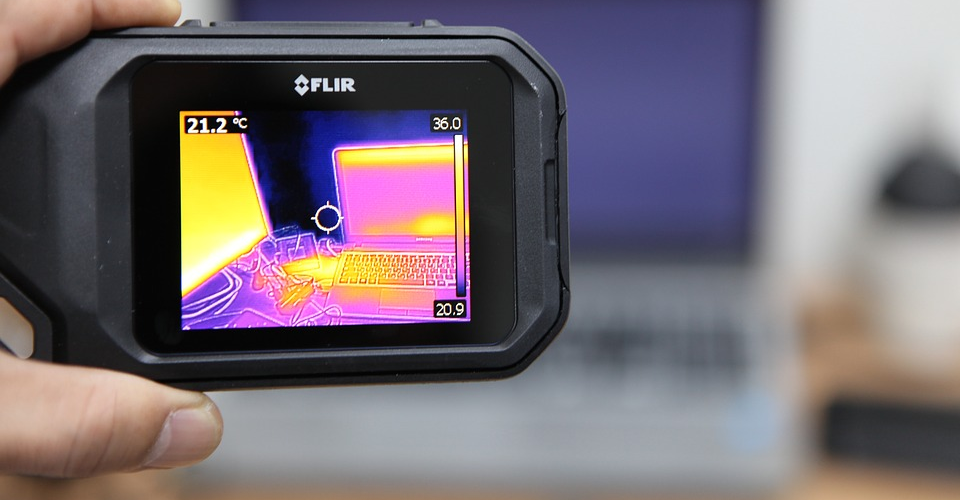5 Best Thermal Cameras for Drones
Drones have become incredibly useful tools across several industries. Aside from the fact that they can access areas that people normally couldn’t and can cover huge distances quickly, they can also be outfitted with a number of accessories that give them impressive versatility.
One of the more specialized applications of drones is aerial thermal imaging using infrared cameras. A drone with an infrared camera is obviously far less common than those with 4K cameras, but don’t worry: if you need one, we’re here to help you out. Check out our list of the best professional-grade drones that come with thermal cameras.
The top 5 best thermal cameras with drones
A quick word about thermal cameras and drones: it’s rare to find a drone that comes pre-installed with a thermal camera. Being niche products, thermal cameras are often sold separately from drones. Thus, some of the entries in this list may recommend either drone and camera bundles, or just thermal cameras designed for drones.
1. Best overall: DJI Zenmuse XT2 for DJI M200 Series
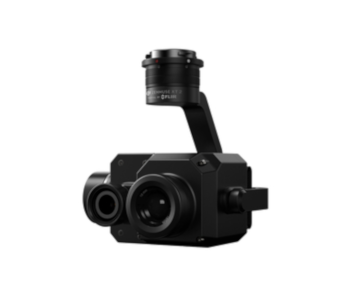
The Zenmuse XT2 dual thermal and imaging camera is the results of the collaborative effort of DJI and FLIR. By integrating FLIR’s thermal camera and DJI’s very own 4K imaging sensor, the Zenmuse XT2 can deliver a live feed that displays both thermal imaging data and a live video of what the drone is capturing. This is an extremely power combination, and we can just imagine all the ways that it can be used The Zenmuse XT2 is compatible with the DJI Matrice 200 series, the Matrice 210 (RTK), and the Matrice 600 Pro.
DJI is well-known for the smart features of their drones, and it’s a pleasant surprise that these features have also extended to the Zenmuse XT2 thermal camera. HeatTrack mode identifies the hottest spot in the camera’s field of view and follows it as it moves. The Temp Alarm feature allows the user to set a threshold temperature value and will give off an alarm if the limit gets breached. Using the camera’s vision sensors, the QuickTrack identifies any subject in the camera’s view and tracks it around.
With a thermal sensor with a 30 Hz refresh rate, up to 8x digital zoom, and IP44-rated construction, the Zenmuse XT2 is a showcase of the best that DJI can offer professional thermal camera users. It provides an impressive level of situational awareness, which can come in handy in various emergency response situations or other commercial applications.
2. FLIR Vue Pro R
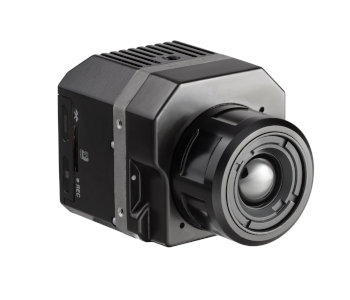
Drone gimbals aside, there are some drone thermal cameras that exist independently. They don’t come with any proprietary accessories for attaching to drones, making them a little less convenient but also more versatile. Unsurprisingly, our top pick for such as a thermal camera comes from industry leader FLIR.
The Vue Pro R is available in several variants, each with different lens sizes, resolution, refresh rate, and field of view numbers. No matter which combination of specs you go for, you’ll get a camera with an Uncooled VOx Microbolometer thermal sensor and an operating range of -20 to 50 °C.
One thing that separates the FLIR Vue Pro R is its use of radiometric technology to determine temperature readings at specific spots of the camera’s view accurately. This pinpoint precision goes beyond mere estimates and actually provide readings for individual pixels, which is quite an impressive feat and can be very useful for lots of applications.
Although it’s a top-of-the-line thermal camera, what the Vue Pro R lacks is an optical sensor. This can make it quite difficult to identify heat sources in the field. Your best bet would be to use the Vue Pro R with a camera that already has a built-in optical camera, such as the Mavic 2 Enterprise.
3. Yuneec CGOET Thermal Vision Camera
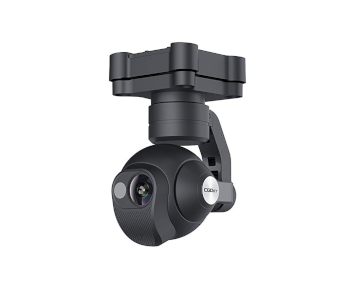
Being one of the top brands in the professional drone industry, Yuneec also has an entry into the thermal camera market. The CGOET Thermal Vision Camera is a hot-swappable camera and gimbal combination that is compatible with the Yuneec Typhoon H and Typhoon H520 models.
The CGOET Thermal Camera also features a dual-sensor setup that incorporates the thermal sensor and a 1080p camera into one compact device. This allows for overlaying of thermal data with visual images, better allowing a user to identify sources of heat with higher accuracy. Various settings are integrated into the camera, which gives users control over the opacity of separate layers to create images crafted to their intention.
There are a few things that make the build of the CGOET thermal camera and the Yuneec drones unique. First is the fully retractable landing gear of the compatible Yuneec drones that allow the gimbal to rotate the full 360 degrees with no interference. This can be very useful for doing constant sweeps of a search area without having to maneuver the drone.
The hot-swappable design of the Yuneec drones is also quite convenient if you anticipate having to switch between different camera attachments. Yuneec offers a wide range of specialty cameras for their professional line of drones, including a 4K camera and a camera with a powerful zoom lens.
4. FLIR Duo Pro R
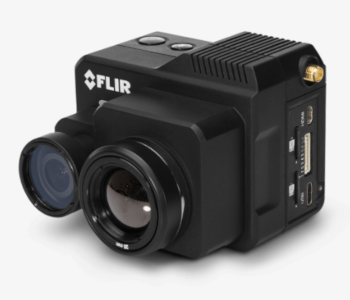
Another entry from FLIR, the Duo Pro R is their very own version of the dual-sensor cameras of DJI and Yuneec. By combining a 4K camera with their own 640p radiometric thermal sensor, the Duo Pro R offers the ultimate imaging solution for professional drone pilots.
Like the Vue Pro R, the Duo Pro R is available in several variants with different combinations of resolution, field of view, and refresh rate numbers. It comes with interchangeable lenses and an Uncooled Vox Microbolometer thermal sensor. The standard tripod mount should ensure compatibility with a wide range of professional-grade drones such as the DJI M200 series or the DJI Mavic 2 Enterprise.
Bundled inside this compact device is an array of sensors, including an accelerometer, magnetometer, IMU, barometer, and GPS receiver. If you’re looking to create orthomosaics out of several aerial thermal images, all the sensors and features you will be needing are fully integrated into the Duo Pro R. Since it is not proprietary to any drone brand, the Duo Pro R can be used with just about any popular professional drone, so we’re giving it plus points in versatility.
5. DJI Zenmuse XT for M100, M200, M600, and Inspire 1
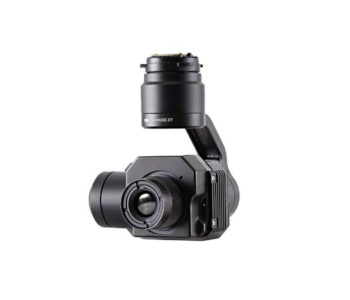
The Zenmuse XT is the older brother of the Zenmuse XT2. Unlike its predecessor, the Zenmuse XT is compatible with older DJI drone models like the M100 and Inspire 1. However, it has one huge disadvantage: it does not have an integrated optical sensor.
Developed in 2016, the Zenmuse XT was the first thermal camera that was specifically developed for drones. It was also designed by DJI together with FLIR, marking the first collaboration between the two giants of their respective industries.
The Zenmuse XT thermal camera provides high-sensitivity (<50 mK) thermal imaging at up to 30 fps. It’s available in two versions with different resolution values: 640 x 512, and 336 x 256. Depending on which version you get, you get a camera with 2x to 8x digital zoom capability.
Aside from having different resolutions, the two versions of the Zenmuse XT also have very different functions. The Performance Model focuses on speed, giving you a quick estimate of the temperature at the center of the camera view. The Radiometric Model, on the other hand, focuses on accuracy by allowing you to click anywhere on the camera view to see the temperature reading at that spot.
The Zenmuse XT may not come with a lot of smart features and may lack an optical sensor, but it was the most sophisticated drone thermal camera at the time it was launched. Although it seems underpowered now, it’s still an excellent choice if you need a thermal camera at a lower price tag.
How does an infrared thermal camera work?
We know from watching movies, and TV shows that thermal cameras can be used to “see” the heat from objects, even when in complete darkness. From this basic understanding alone, it’s already easy to realize how useful thermal can be for search and rescue or if you’re an extra-terrestrial predator hunting for prey. But how exactly do these thermal cameras work?
The more technical term for a thermal camera is an infrared camera. In the same way that our eyes and other conventional cameras can see objects by their reception of energy in the spectrum of visible light, infrared cameras are designed to be sensitive to infrared radiation. This is merely another form of energy that has a longer wavelength and small frequency – energy that is not visible to the naked eye.
Here’s the thing about infrared radiation: all objects emit a particular amount of it. What makes it useful as a detection tool is the fact that hotter objects emit a larger amount of infrared radiation. The lens of a thermal camera receives all the infrared radiation in its field of view and concentrates it towards a detector.
Since the raw infrared data still cannot be interpreted by the human eye, the data is processed to a thermogram, a set of temperature distribution data based on the infrared radiation levels. The numbers from the thermogram are then transmitted to the camera’s display panel, where they are converted to colors from the visible spectrum. This is the reason why thermal images are typically represented using similar color schemes – red for hottest areas, blue for coldest areas, and a spectrum of colors for all temperature values running between the extremes.
What are the applications of drones with thermal cameras?
In the hands of a skilled user, an infrared thermal camera can be a very powerful tool. Whether it’s through live thermal imaging or the reconstruction of a thermal map using several airborne images, drone-mounted thermal cameras have proven to quite useful in improving the way things are done in several industries. If you need any more convincing about getting a drone with a thermal camera, then here are just some of its possible applications.
1. Power line inspection
Power generation and distribution companies will often conduct an inspection of power lines as part of regular maintenance or if something goes wrong in the grid. It’s easy to imagine how identifying problem areas can be difficult if you have power lines that stretch out to hundreds of miles. Fortunately for drone pilots, this problem presents the perfect opportunity.
The ease with which drones can fly over huge distances makes them especially suited for the job. A thermal camera mounted on a drone can easily pick up on “hot spots” where electricity transmission is compromised. If you’re planning on taking such a job, just take note that power lines generate a large amount of electromagnetic noise, so you’ll need to fly defensively.
2. Telecommunications tower inspection
Similar to power lines, damaged portions of telecommunications towers can give off an unusual amount of heat. However, these towers are huge, and the mere act of inspecting them can be a costly and very hazardous activity. By having drones do the job, telecommunications companies can greatly reduce the risk to personnel and keep their costs down. A win-win for everyone involved, including the drone pilot.
3. Solar farm inspection
Solar farms are huge and having to check solar panels every now and then can take a lot of time and manpower. Drones with thermal cameras, however, might only need a few minutes. A solar panel that is not working as expected should have an unusual amount of heat buildup, which can be easily identified in a solar image.
4. Building and roof inspection
Drones with thermal cameras have also been heavily utilized by construction firms who often do a quick flyover of recently finished buildings or buildings due for maintenance to identify any damages in the building’s insulation. With a thermal camera, any leaks of the building’s internal heating can be easily found – all without a single person having to scale down the building’s walls.
5. Search and rescue
In a lot of emergency situations that require search and rescue response, time is of the essence. If rescuers can reach the distressed parties as soon as possible, then they can better ensure their survival. For this reason, helicopters are often deployed by search and rescue teams to cover the search area faster.
Drones have a bit of an advantage of helicopters. They are smaller, cheaper, and can fly closer to the ground. With a thermal camera, drones can continue searching even in complete darkness. Even better is the fact that humans can be very quickly found in a live feed from a drone’s thermal camera.
6. Firefighting
Firefighters use thermal cameras when most of the firefighting work has already been done. By doing a quick sweep of the area, leftover areas that are still smoldering can be easily found without having to put any person in direct danger. These small pockets where flames are still smoldering can quickly grow to another huge fire if not addressed.
7. Pipeline inspection
Similar to power lines, pipelines can extend several miles, making them very hard to inspect for damage. In most industrial settings, there can be several pipelines laid beside each other to transport different types of fluids. A quick scan by a thermal camera of pipelines can help maintenance teams identify leaks, especially if the pipelines are being used for fluids that are at a different temperature to their surroundings.
8. Surveillance
Just like in search and rescue, thermal cameras can be used for security and surveillance to pick up the heat signature of people even in complete darkness. The great thing about using thermal cameras instead of standard cameras is that their feed quality cannot be compromised by rain, fog, or any phenomenon that can impede vision. Drones are also perfect for surveillance because they can go virtually anywhere – although, they can be very noisy.
Final thoughts
Thermal imaging is easily one of the most specialized things you can do with drones, and therefore, one of the most lucrative. And while thermal cameras are some of the most expensive accessories you can get for a drone, a successful career in thermal imaging is the stuff of a professional drone pilot’s dreams. A good thermal camera is a good start, and we hope that our list has helped you pick the right one based on your budget and requirements.

